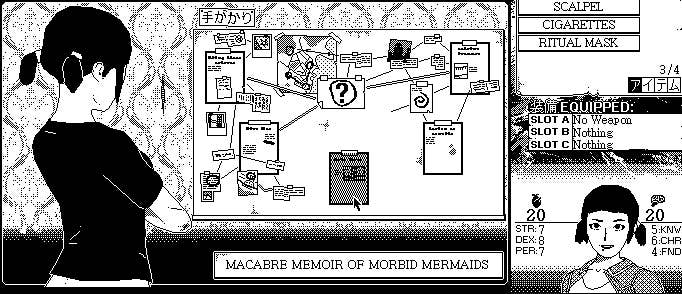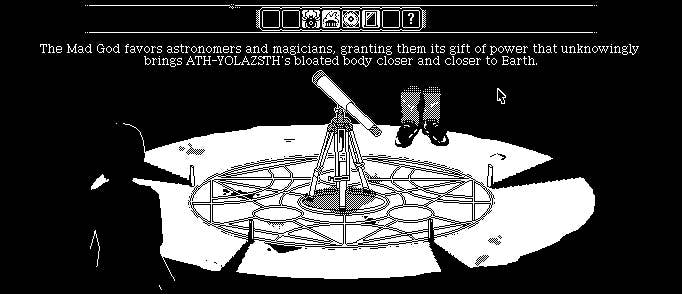The Backbone of the 1-Bit World of Horror is a Card Game
The Junji Ito-inspired World of Horror may not seem like a card game, but beneath the surface it is.
This article first appeared on USgamer, a partner publication of VG247. Some content, such as this article, has been migrated to VG247 for posterity after USgamer's closure - but it has not been edited or further vetted by the VG247 team.
World of Horror first caught my eye ages ago. I was writing regularly for a small website the covered indie games almost exclusively, when a colleague wrote about it and the peculiar demo for it that popped up on itch.io. Immediately, it caught everyone's eye. Utilizing a 1-bit Macintosh art style and a Junji Ito-inspired aesthetic, World of Horror was instantly engrossing. And in the year-plus that's followed, it's landed a publisher in Ysbryd Games and has gotten bigger ever since.
At PAX West 2018, I played the latest build of World of Horror. While it's mighty different from the simpler demo from early 2017, it feels more layered now. When I was told that the events are procedurally generated, from the enemies you encounter to the characters you meet, I was surprised. World of Horror is the sort of game that doesn't feel generated, because what you're navigating are solely text prompts and events. Yet it's all randomized, so no two enemies or events that transpire on a single playthrough will ideally be the same.

"I started creating my own physical card game-slash-board game just for me and my friends," says Poland-based developer Pawe? Ko?mi?ski, also known as Panstasz. "But it was way too much [work] for me, so I decided to make a game." Ko?mi?ski's love for card games like Magic: The Gathering paved the way for the intricately designed World of Horror. And though at first glance it may not look like a card game, it functions fully as one—decks, randomization, and all.
In my demo, I was tasked with exploring a school and finding what I needed to hold a seance. I had a limited number of functions, and sometimes when exploring miscellaneous locations I'd be treated to a scary sighting like a silhouette in the background—no jump scares though, don't worry—or an unnerving ambush for a battle. My investigation, to be completely honest, didn't go too well. The character and enemy design is where the 1-bit style really shines, stretching a lot of detail out of very little.
In its turn-based battles, you have a meter you fill up with attacks, defensive maneuvers, and other functions. (For the demo, spells and other specific skills were advised against due to demo-breaking bugs; so it goes.) At first, it was a hard to wrap my head around. Then, after a few deaths and obvious missteps of course, it clicked. My meter had a certain amount of abilities I could fill it with, and each ability is ascribed with a number. I'd typically charge up attacks, attack, and then kick back for a defense maneuver in the event of the inevitable blow back.
It did feel like a card game, as Ko?mi?ski intended, despite the "cards" for each move being formatted to fit into something more similar to a turn-based RPG battle than a round of Hearthstone. It's not the only aspect that feels card game-like though. "That's where the deck-building comes in. All events, all cards, all enemies are presented in card form. They're creating and assembling different decks that events are taken from," says Ko?mi?ski. "The player can tailor the cards to tailor their experience. Yeah, there are currently more than two hundred events in the game."
That number surprises me—200—knowing that the version of the demo I got is not the same as what others got. There's a lot of surprising replayability with that number, especially considering the five mystery scenarios starring different characters overall and the many combinations those can take. It reminds me of another card-based game from this year, Cultist Simulator. Cultist Simulator takes an opposite but similar approach to World of Horror. Essentially, Cultist Simulator is more of a pure adventure game, only it's given a very loose structure in being a card game. The two games are kind of like two sides of the same coin; one uses card games as an inspiration for its backbone, while the other literally uses cards as a means to add a random element and usher its many stories forward.


In the menu, I saw another function too: 2-bit, in addition to the base 1-bit. You can change the color palette easily with this, but I stuck with the classic black and white for my playthrough. Ko?mi?ski tells me the primary difference between the two is really how many colors you want on the screen. "1-bit is the purist mode," he says. "That's purely for Macintosh fans, two colors with different palettes. And with 2-bit mode, we've got four different colors. So that's slightly expanding what we can see on the screen." In terms of the pixel art, nothing changes between the two modes.
At PAX West's The Mix Indie Exchange, World of Horror was selected as the Best of Show out of the many indie games on display. World of Horror is currently eyeing a release in 2019 for Nintendo Switch, PC, and PlayStation 4. In the meantime, you can play its free demo on itch.io.
Disclosure: USgamer is owned and operated by ReedPop, which also runs the PAX family of shows.

